Challenging Orthodoxy at New America School - Las Cruces
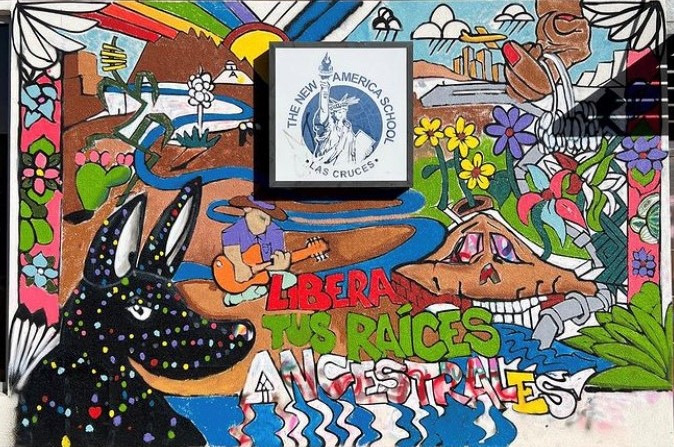
A mural, designed and painted by students, in front of NAS-LC that reads, "Libera tus raices ancestrales” or “Liberate your ancestral roots.”
New America School - Las Cruces (NAS-LC) is challenging traditional education systems by providing the best and most innovative education to the students who need it most. They view their students and families as assets that deserve creative, effective, and accessible programs for the community. NAS-LC has used Innovation Zone funding from the state to provide paid work experience, culturally relevant classroom preparation, hands-on learning that is designed for credit recovery, and more.
Launched in 2021, the Innovation Zone (IZ) initiative provides schools with resources and training to develop graduate profiles, work-based learning (WBL), Career and Technical Education (CTE), capstone projects, and personalized student support. NAS-LC is now in its second year as an IZ school.
Las Cruces, New Mexico, is the second largest city in the state and the economic center of the Mesilla Valley in southern New Mexico. The city has a diverse population, with a significant Hispanic and Latino community, as well as a growing immigrant population, which aligns with the New America School's original mission of serving recent immigrants and English language learners. Its mission has since broadened to include all academically underserved students, ensuring equitable education access for all.
The Las Cruces campus started in 2012 when Superintendent and Principal Margarita Porter moved back to her hometown of Las Cruces from Albuquerque to open the school. Porter works relentlessly for her students, teachers, and staff - ensuring they get all the support they can - because she believes in the school’s mission and in her students.
“I think the stereotype and what people think of when they think of the academically underserved and when they think of our students is that they don't care about education,” says Porter. “But that is absolutely not the case with our students. Because when we do give them opportunities, most of them absolutely rise to the occasion and get really excited.”
Students from all backgrounds are rising to the occasion and participating in the new programs, according to the school’s IZ Coordinator, Kayla Avila.
“We have had students who were experiencing houselessness,” says Avila about the school’s internship program participants. “We’ve had young mothers, young families, and special education students. We’ve had a couple of English language learners.”
“I think the stereotype and what people think of when they think of the academically underserved and when they think of our students is that they don't care about education. But that is absolutely not the case with our students. Because when we do give them opportunities, most of them absolutely rise to the occasion and get really excited.”
- Superintendent Margarita Porter
HOw they're innovating
Hiring a full-time IZ Coordinator, Kayla Avila, was key to NAS-LC’s innovation efforts. Under her leadership, the school began the IZ process by developing a graduate profile. They surveyed students, community members, and family members and held focus groups to co-create a strong graduate profile. They completed the profile and unveiled it in the Fall of 2024 to overwhelming student and community support.
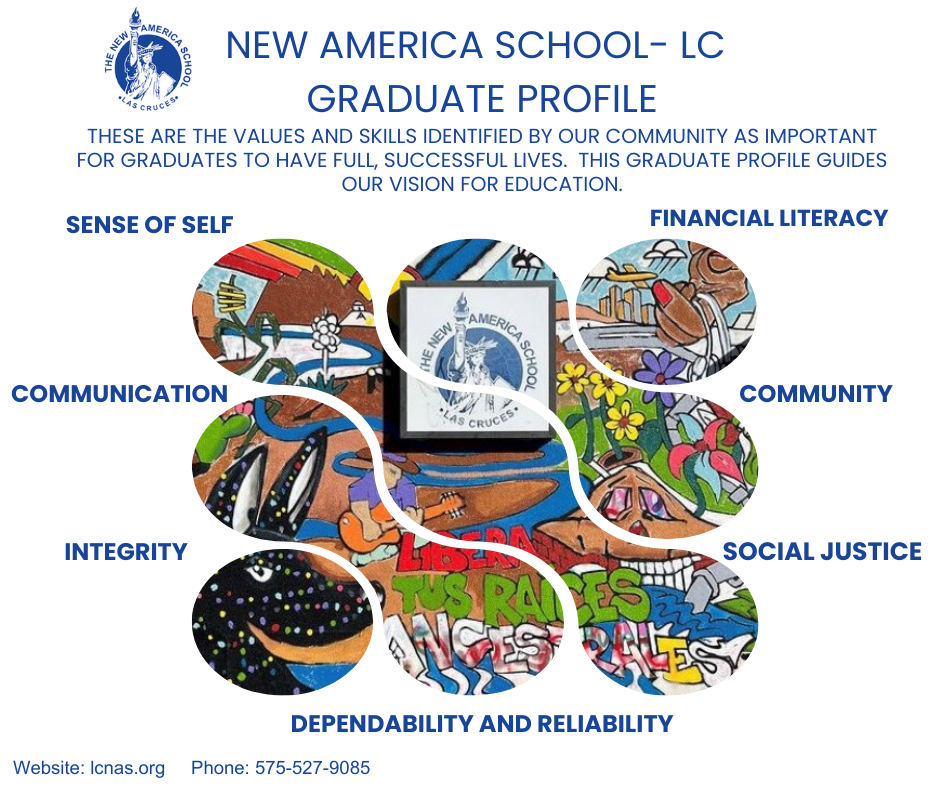

NAS - LC Graduate Profile, front and back
At the same time, NAS - LC has been working hard to maximize the opportunities IZ funding can provide, like implementing programs they've developed to better serve students in their community.
accessible adult education
The increase of funding from Innovation Zones allowed NAS-LC to move funding around to support older students with their adult education program, which offers classes at night for adults over 22 years old who are finishing their high school diplomas. Currently, there are over 50 students in the program. These students, who for various reasons have not received a high school diploma, are working toward one now so that they can go to a trade school or military school or get the opportunity scholarship or lottery scholarship to go to college in New Mexico. This has a positive multigenerational impact for families.
“A lot of them come to inspire their kids,” says Avila. “They show their kids it's possible. So it ends that cycle of dropping out.”
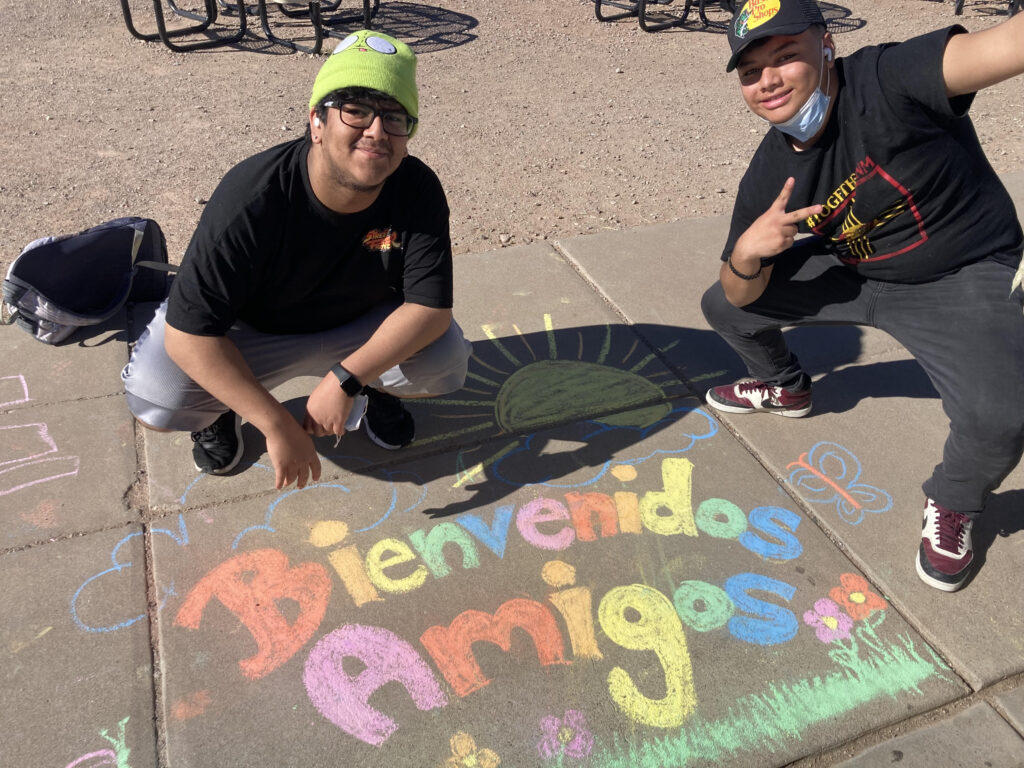
NAS -LC students posing with their sidewalk chalk.
paid internships and Work-based Learning
New America School is partnering with local businesses, government, and nonprofits to create new, paid internship programs for many of their students. In 2024, they had 11 students complete their internships–in 2025, they are up to 19. And since the majority of NAS students deal with poverty, paying them for internships is crucial.
“One of the bigger reasons that we see students leave their education is to work. And we wanted to give them an opportunity to earn money but also to get on a career path that could lead them to something that they love, could lead them to college,” explains Avila.
Students are excited about these new internships, which help keep them engaged. Participating interns need to be present at school 80% of the time and maintain passing grades in order to keep their spot in the program, and Superintendent Porter says she's seeing attendance and engagement increase as a result.
“We had students last year that never came to school but started coming so they could finish their internships. So it's been a good retention strategy as well. And then a lot of the students have said in their reflections that they found a reason to come to school because now they have something they are working toward,” says Porter.
“One of the bigger reasons that we see students leave their education is to work. And we wanted to give them an opportunity to earn money but also to get on a career path that could lead them to something that they love, could lead them to college." - Innovation Zone Coordinator, Kayla Avila
Internship sites have ranged from real estate to community organization, from New Mexico State University (NMSU) to restaurants, maker spaces, and salons. Multiple students have been hired by their internship sites after their internship ended, and one student who wasn’t going to go to college changed his mind after his internship at NMSU and is now enrolled there.
NAS-LC also became the first school to work with the New Mexico Department of Health. In spring 2024,three student interns were given the opportunity to work on public health campaigns. The students had been interested in the health field, but when the local hospital only offered to give them janitorial positions, Avila says she felt that they could learn more elsewhere. It took almost a year, but now the students are learning about public health, getting paid, and receiving invaluable on-the-job experience.
This is the kind of individual advocacy and support that can happen when a program gets enough support. It isn’t just businesses, government agencies, or nonprofits that can benefit from offering internship opportunities, schools can, too. Avila and NAS-LC created an internship position at their school after it came to their attention that a bilingual student was going to classes he wasn’t in just to translate for English language learners and teachers. Now, there are other student interns in the program, too.
“They're honored for their bilingual skills,” says Avila. “Teachers look to them for support and we're not asking to do unpaid labor translating, which happens a lot.”
The partnerships that NAS-LC has been able to create with local businesses, government agencies, and nonprofits have not just involved internships. In 2024, students partnered with a maker’s space called Cruces Creatives to design and paint a mural on the outside of their school that reads, “libera tus raices ancestrales” or “liberate your ancestral roots.” The project was particularly significant for the school’s Indigenous students, who worked with a local Navajo artist in the process.
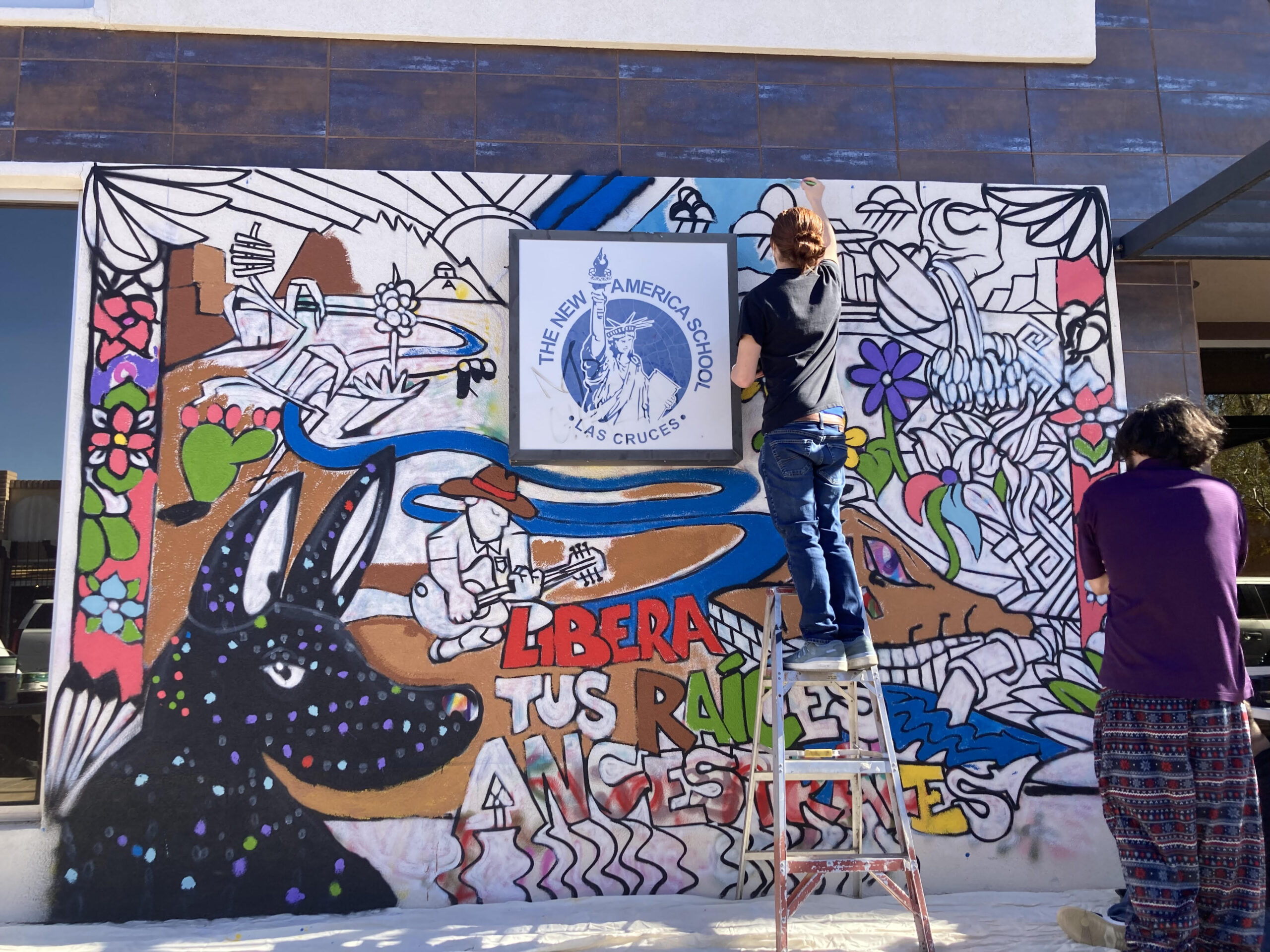
NAS -LC students painting their mural.
Project-based credit recovery program
For students who have missed out on credits after not completing a course they now have an option to recover those credits without taking the class again. Avila and Porter have implemented a program that aims to give the most at-risk students a different pathway to reaching their goals through meaningful, community-focused, project-based work.
These project-based credit recovery projects have agreed-upon requirements and competencies and ensure that students are learning what they need from the experience. Right now, New America offers credit recovery for English and Social Studies, but they hope to expand the program with more funding. Organizing and implementing these types of individual projects takes a lot of time, but according to Avila and Porter, it’s more than worth it.
“These projects give them a chance to explore something that's heavy for them or that they're missing and still get class credit,” explains Avila. “And they have to connect with the community. They can't do it in a silo.”
One unhoused student found that his credit recovery project provided connection with the community and relieved some feelings of loneliness. The project, a study of masculinity and male loneliness, also made a lasting impression on both Avila and Porter. The student read scientific research, did cultural analysis, and attended and observed a support group before starting his own group at the school. The student reached his goals and was able to do something meaningful to him while recovering credits.
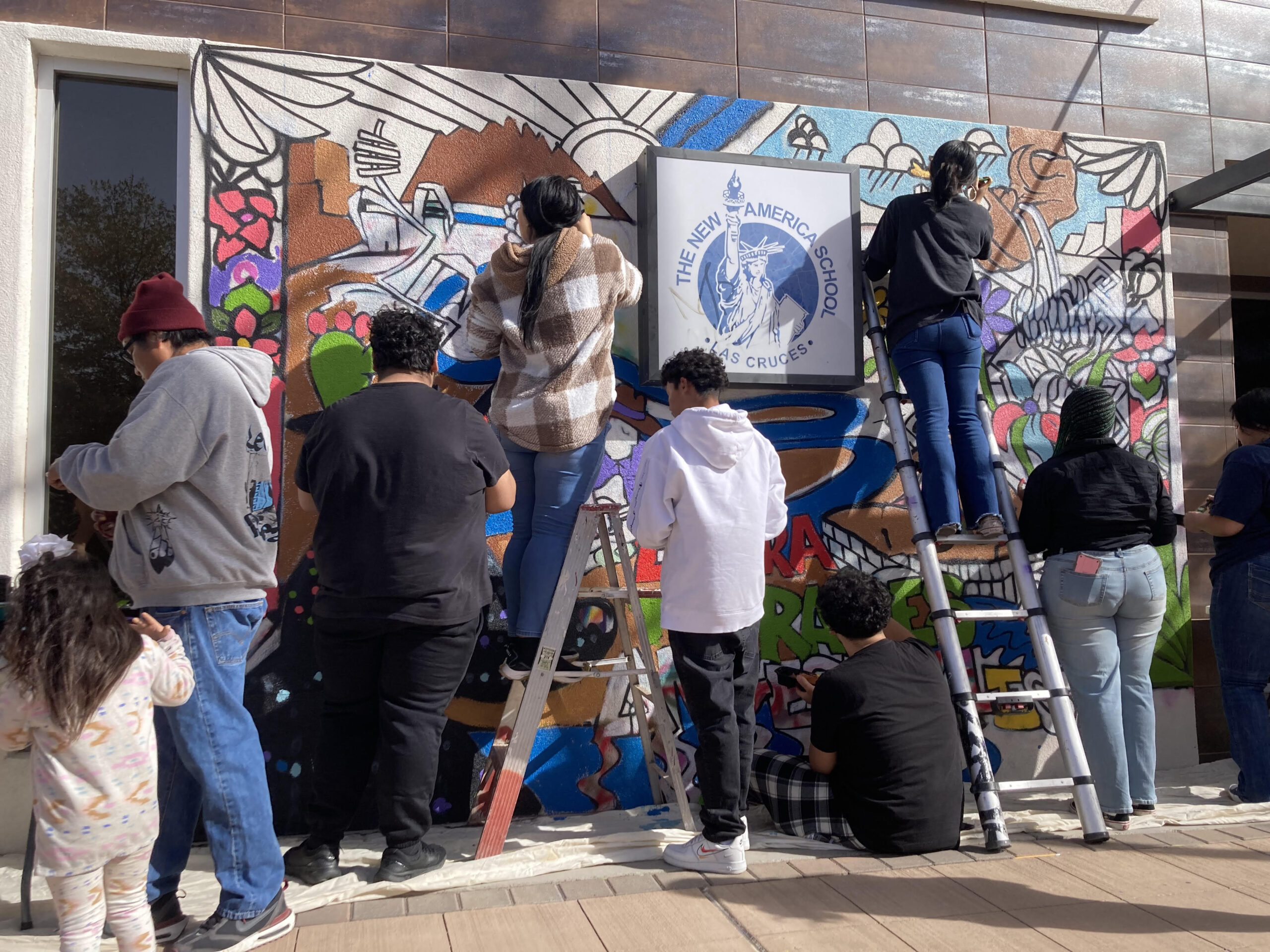
NAS -LC students painting their mural.
classroom preparation
While internships often get the limelight, the classroom preparation that students go through is equally, if not more important. Students take once a week internship classes while they are interning. They take a class called Ethnic and Gender Studies from Ms. Avila before they can take their capstone class, Capstone in Community II.
She describes her Ethnic and Gender Studies class as “Tailored to digging deeper into the cultures, the rich, beautiful histories, the strengths of our students, and also the struggles that they're facing.”
The class gives Avila a good way of determining the interests and needs of the school and students.
“And it's a place where they can bring their questions and their fears and figure out how to have conflict and to resolve conflict and to talk about different points of view,” says Avila.
These interpersonal skills are just as important as academic skills - especially for their internships. What students learn in Ethnic and Gender Studies is largely skill-building and prepping for what they do in their Capstone in Community II. Then, by the time they’re doing a capstone - which requires working in the community, even if they don’t do an internship - students have gone through a whole year of learning how to communicate and build empathy, how to talk to and about who lives in their communities and how to have difficult conversations. The Capstone then requires them to take action on an issue that they choose as a collective.
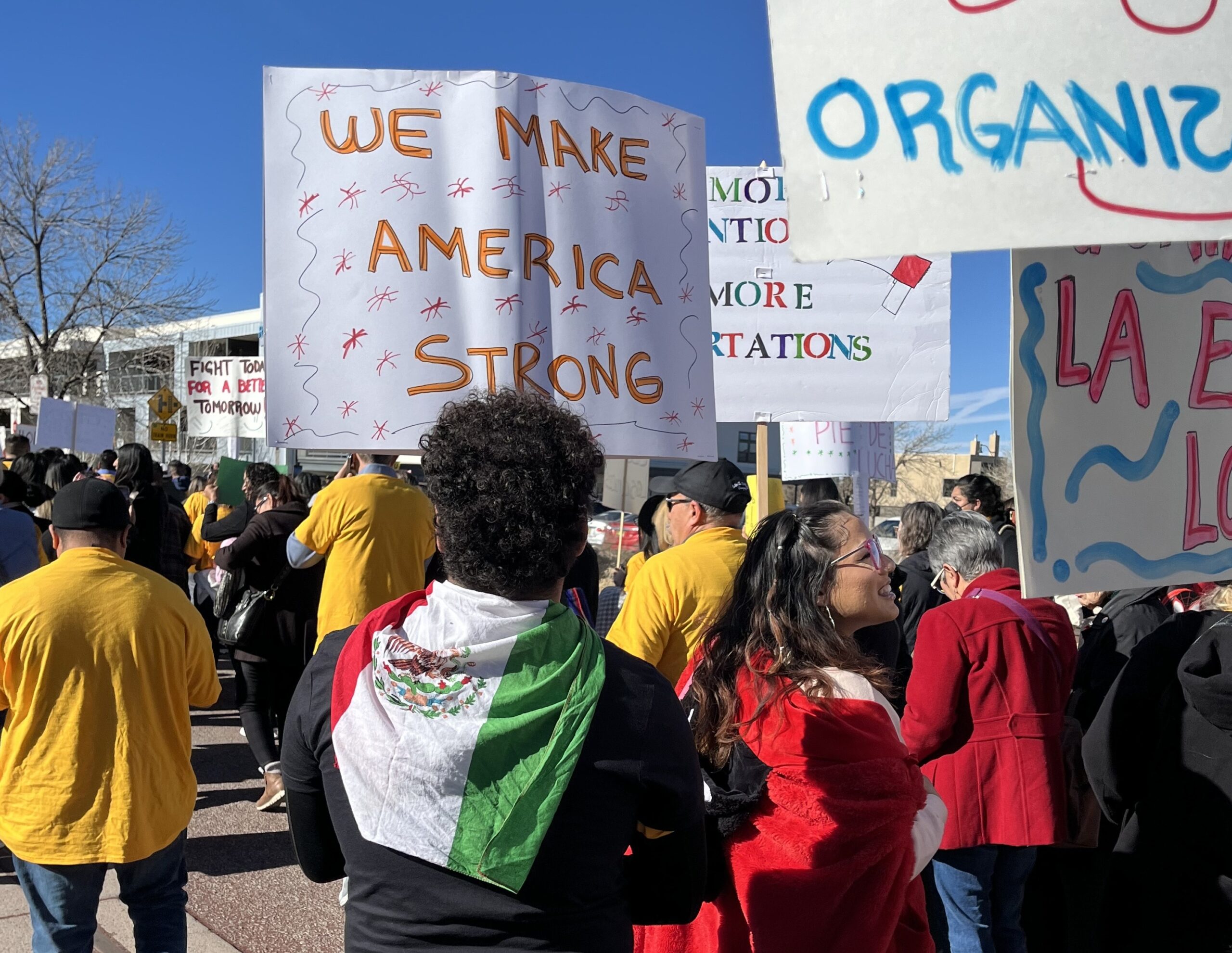
NAS -LC students marching in Santa Fe for Immigrant Day of Action 2025.
New America School - Las Cruces is proving that with the right support, students can thrive despite systemic barriers. With the support of Innovation Zones, the school is redefining what education looks like for academically underserved students - offering real-world learning, career opportunities, and meaningful community engagement. By prioritizing student needs and voices, NAS-LC is not only improving outcomes but also shaping a more inclusive and equitable education system.


Comments
Las Cruces is so blessed to have this fantastic school available free of charge.
I am pleased the school is using Kayla’s broad based knowledge and deep skills/abilities. I had the oportunity to work with her as a Professor in Anthropology. She is a high level scholar in Indigenous studies. Moreover she continues to help people improve their quality of life.